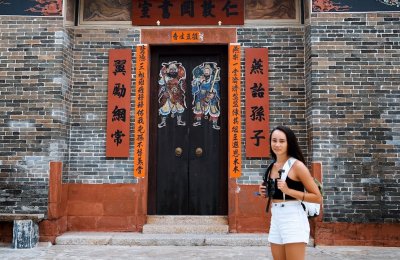On September 30, a diverse group of local high school students was afforded a first-hand look at the future of journalism at Wallis Annenberg Hall, with 109 freshmen, sophomores, juniors and seniors attending workshops geared towards the use of social media, mobile and other storytelling tools.
The third biannual High School Journalism Day was organized by Jaime Carias, USC Annenberg’s civic engagement coordinator, and is part of an ongoing effort to better connect Annenberg faculty and students with the greater Los Angeles community. Last fall, 25 students from Communication and Technology School in Los Angeles participated in the inaugural Journalism Day, and the program grew from there to a spring event involving 70 students from five different high schools.
For Carias, the day offers participants a valuable opportunity to be on a college campus, while also teaching them about journalism, media, technology and communication.
Students realize “there is an opportunity for a career in education, media, technology, communication, and, most importantly, that they have the power to tell their story and the story of their community,” Carias said. ”Many times when media tells stories about South LA, East L.A., Boyle Heights, it’s negative stories about all the bad that’s going on and not about the good or success going on.”
The 109 students, from 10 high schools in South and East Los Angeles and Long Beach, learned about digital storytelling, met with Annenberg faculty and took a tour of the Julie Chen/Leslie Moonves and CBS Media Center Media Center. This year’s expanded program included an alumni panel, a keynote delivered by Wallis Annenberg Chair in Journalism León Krauze, and professional development seminars for the high school teachers in attendance.
In an assembly before the workshops, Willow Bay, the School of Journalism director, shared her vision of journalism education focused on the power of words and images.
“We teach students how to use those words and images accurately, effectively and wisely. We teach them how to harness current and emerging technologies in service of really powerful and compelling storytelling,” Bay said. “We teach them about the awesome responsibility of telling other people's stories. Here at the school they don’t just study journalism, we actually practice journalism.”
León Krauze delighted the students with stories of his time working in Mexico as a journalist. Krauze also shared his experiences interviewing world leaders such as President Barack Obama, as well as what it was like crafting “La Mesa,” a project built almost entirely out of on-the-street interviews of Los Angeles’ Hispanic residents.
Krauze shared that, for him, journalism is a “boxing match” between an interviewer and interviewee.
“What is journalism for?” Krauze asked. “Journalism is a tool against power. Journalism speaks truth to power, it confronts the powerful, it holds the powerful accountable. When journalism is seen as a tool against power, it’s indispensable for a healthy society and for a journalist it’s lots of fun.”
For some of the students, it was their first time in a modern newsroom.
Amber Figueroa, a senior at Francisco Bravo Medical Magnet High School, said being able to experience the broad range of tools available to today’s journalists was eye-opening.
“I think Annenberg is a great school and they offer a lot of opportunities you wouldn’t get in other places. I think they have great equipment and things for the students to learn and get experience on," she said.
Her favorite part of the day was visiting Studio C and seeing how the different cameras functioned.
Another highlight for Figueroa was journalism professor Laura Castañeda’s workshop on how to find compelling story ideas and then tell those stories in new ways.
“I think whether or not the students are interested in journalism, this is a great exposure to higher education and to professors who might be able to help them in the future,” Castañeda said. “When students become voting citizens they need to know how to interrogate information and find the correct information and ask questions. It’s all valuable for them.”
Keith Plocek, an adjunct journalism professor, taught a group of students on how to use Snapchat to tell stories.
“Ideally with all these new platforms, I would like students to think of them as storytelling devices,” Plocek said. “It’s more like teaching how to tell a good story.”
For the high school teachers, Journalism Day was a welcome chance to learn new skills as well.
Robyn Charles, a Certified Technical Educator at Dorsey High School in Los Angeles, said she appreciated the event’s professional development track.
“It’s really invaluable to be able to workshop ideas with the professors who are actually here,” Charles said.
Cathy Phung, a senior at Bravo High School, said she had not previously considered journalism as a career option, but High School Journalism Day had made it seem cool. She works on yearbook in school and picked up skills that she would be able to put to work immediately.
“It makes me reconsider how I’m posting in relation to how I can promote our own school and events going on at our school,” Phung said. “I’m glad our school got the opportunity to come today.”
